| |
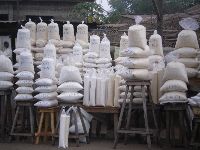 An
interesting part of the African economy is how different villages will have
their own specialization. In the case of this village, perhaps
Paouignan, it is a cassava
or manioc product with dozens of vendors lining both sides of the road. Though
it is unlikely that anyone in town has academically studied it, this is a
dramatic demonstration of An
interesting part of the African economy is how different villages will have
their own specialization. In the case of this village, perhaps
Paouignan, it is a cassava
or manioc product with dozens of vendors lining both sides of the road. Though
it is unlikely that anyone in town has academically studied it, this is a
dramatic demonstration of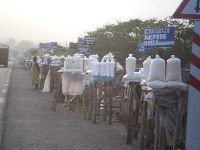 comparative advantage, the cluster effect, the economy of agglomeration (or perhaps the diseconomy of agglomeration) and maybe the
economies of scale. When automobile dealers or shoe shops cluster it
is fairly easy to determine at least some of the differences in the product
(i.e. style, color, size) and there may be some information available about
reputation. In this market ALL of the product seems IDENTICAL so does
that mean the only factor in a purchasing decision is reputation, or is it
total random -- not something economist pretend to understand.
comparative advantage, the cluster effect, the economy of agglomeration (or perhaps the diseconomy of agglomeration) and maybe the
economies of scale. When automobile dealers or shoe shops cluster it
is fairly easy to determine at least some of the differences in the product
(i.e. style, color, size) and there may be some information available about
reputation. In this market ALL of the product seems IDENTICAL so does
that mean the only factor in a purchasing decision is reputation, or is it
total random -- not something economist pretend to understand.
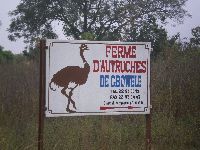 In
the category of curious and unique signs there is this one for an ostrich
farm. Ostriches are suppose to be indigenous to West Africa, but much
further north -- like a thousand miles north in Niger and Mali. Though I haven't noticed
ostrich in
local markets but there is a world market for ostrich feathers, eggshell,
leather and meat, so perhaps this is how this farm survives. In
the category of curious and unique signs there is this one for an ostrich
farm. Ostriches are suppose to be indigenous to West Africa, but much
further north -- like a thousand miles north in Niger and Mali. Though I haven't noticed
ostrich in
local markets but there is a world market for ostrich feathers, eggshell,
leather and meat, so perhaps this is how this farm survives.
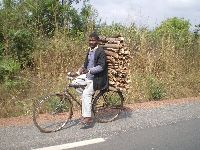 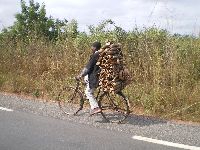 Sticks
and small logs are collected for fire wood in the littoral forests across
West Africa, but only in Benin does it seem to be as consistently Sticks
and small logs are collected for fire wood in the littoral forests across
West Africa, but only in Benin does it seem to be as consistently transported by bicycle, and sometimes for pretty long distances.
transported by bicycle, and sometimes for pretty long distances.
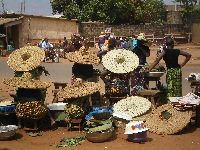 After
a relatively sparsely populated area, the next significant town Bohicon.
The intersection with the roads to Cotonou (the current economic capital), Abomey
and the north, and the adjacent market, is a hubbub of activity. It is
colorful and diverse enough to warrant its own photo essay. The local
headwear rivaled the largest of sombreros in size. Mobile merchants
effortlessly balance oddly distributed loads on their heads and walk to and
fro and hawk their wares. After
a relatively sparsely populated area, the next significant town Bohicon.
The intersection with the roads to Cotonou (the current economic capital), Abomey
and the north, and the adjacent market, is a hubbub of activity. It is
colorful and diverse enough to warrant its own photo essay. The local
headwear rivaled the largest of sombreros in size. Mobile merchants
effortlessly balance oddly distributed loads on their heads and walk to and
fro and hawk their wares.

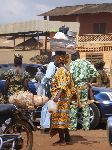
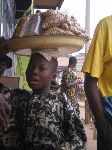
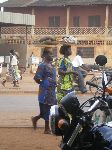
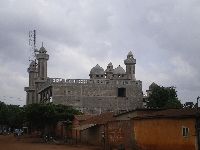 It is about ten kilometers from Bohicon to Abomey. At least
immediately adjacent to the road, for equally far, the land is built up into
a strip city of mostly one-story, corrugated zinc roofed buildings. A
disproportional number of businesses seemed to be automobile oriented;
tires, tire repair, mechanics, fuel, etc. Just about midway is a large
mosque raising to the heavens.
It is about ten kilometers from Bohicon to Abomey. At least
immediately adjacent to the road, for equally far, the land is built up into
a strip city of mostly one-story, corrugated zinc roofed buildings. A
disproportional number of businesses seemed to be automobile oriented;
tires, tire repair, mechanics, fuel, etc. Just about midway is a large
mosque raising to the heavens.
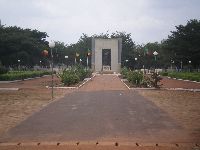 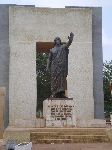 At
the more formal entrance to Abomey is a garden with a monument to King
Gbehanzin (1889-1906). He opposed the French colonial invasion and was
sent into exile in Algeria when he was captured. At
the more formal entrance to Abomey is a garden with a monument to King
Gbehanzin (1889-1906). He opposed the French colonial invasion and was
sent into exile in Algeria when he was captured.
Palaces, shrines, altars and monument of the Dahomey Kingdom and Fon
culture, of which there are many, are the
primary draw for visitors.
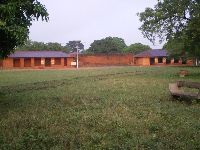 Because
rituals had to be performed for past Kings, new Kings would built a new
palaces, usually nearby if not adjacent to the palace of the previous King.
There is now a cluster of palaces covering a large area of Abomey. The
palaces for the various kings can be distinguished from one another by the
symbols they Because
rituals had to be performed for past Kings, new Kings would built a new
palaces, usually nearby if not adjacent to the palace of the previous King.
There is now a cluster of palaces covering a large area of Abomey. The
palaces for the various kings can be distinguished from one another by the
symbols they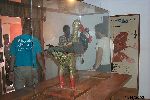 are decorated with. Each king adopted his own collection of symbols
that were representative of his reign. The main palace is also a museum, but
photographs are no longer allow inside so it sort of gets lost in a photo
essay, though the were in 2000, with the photo to the right was taken.
are decorated with. Each king adopted his own collection of symbols
that were representative of his reign. The main palace is also a museum, but
photographs are no longer allow inside so it sort of gets lost in a photo
essay, though the were in 2000, with the photo to the right was taken.
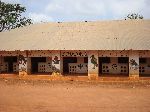 Legend has it that while walking in the
forest looking for water the daughter of the King of Tado (a Yoruba)
encountered a panther spirit. From that union the princess gave birth to a son, Agasu,
who became the
first king of the Fon. Henceforth panther is the totem of the Fon. The king
had three sons who moved to Allada (Benin). The oldest becomes King of Allada. There
was a falling out and
middle son becomes King of Porto Novo. The youngest becomes King of Abomey. Legend has it that while walking in the
forest looking for water the daughter of the King of Tado (a Yoruba)
encountered a panther spirit. From that union the princess gave birth to a son, Agasu,
who became the
first king of the Fon. Henceforth panther is the totem of the Fon. The king
had three sons who moved to Allada (Benin). The oldest becomes King of Allada. There
was a falling out and
middle son becomes King of Porto Novo. The youngest becomes King of Abomey.
Throughout its history each Fon (king) had special symbols and proverbs associated
with his rule. The symbols were used to decorate wall hangings, flags,
umbrellas, buildings and other royal items during the rein of the Fon.
The Fons were as follows:
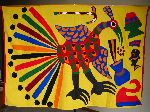 Gangnihessou: 1600-1620, the King of Allada and the big brother of the first
Fon (king) of
Dahomey. Royal Symbols: bird and drum (“The bird
spoke so loud that the drum sounded." And/or "The bird, called Saswé,
is known for its greediness. Just like the prince, it will leave nothing to
others.") Gangnihessou: 1600-1620, the King of Allada and the big brother of the first
Fon (king) of
Dahomey. Royal Symbols: bird and drum (“The bird
spoke so loud that the drum sounded." And/or "The bird, called Saswé,
is known for its greediness. Just like the prince, it will leave nothing to
others.")
Dakodonou: 1620-1645. Royal Symbols: indigo jar & "briquettes"
("Dako killed his beautiful mother and the indigo jar rolled." Or "One day, Dakodonou
took his enemy Aîzo by surprise when he was preparing indigo dye. After
killing him, he put the body in the indigo jar and rolled it away.")
 Houegbadja: 1645-1685.
Royal Symbols: fish and wicker trap (As a prince, he once avoided a trap which
had been set for him. Proverb: "The
fish escaped the trap and returned plentifully".) Houegbadja is the founder of the kingdom of Dahomey and the city
of Abomey. It descends from the reigning dynasty of Tado (now Togo). It
took the power of Guedevis (Yoruba) living on the plateau. Houegbadja established
a state administration and consultation structures. He
appointed ministers, a chief doctor, chief of the King and chief of religion. He pursued
a policy of expansion, enlarges the kingdom to the rivers Zou and Coutto
without war, with bans on arrangements with the natives. His symbols - the fish, trap, the
hoe handle - mean that he would not enter a trap, he was cunning and
always ready to defend himself. Houegbadja: 1645-1685.
Royal Symbols: fish and wicker trap (As a prince, he once avoided a trap which
had been set for him. Proverb: "The
fish escaped the trap and returned plentifully".) Houegbadja is the founder of the kingdom of Dahomey and the city
of Abomey. It descends from the reigning dynasty of Tado (now Togo). It
took the power of Guedevis (Yoruba) living on the plateau. Houegbadja established
a state administration and consultation structures. He
appointed ministers, a chief doctor, chief of the King and chief of religion. He pursued
a policy of expansion, enlarges the kingdom to the rivers Zou and Coutto
without war, with bans on arrangements with the natives. His symbols - the fish, trap, the
hoe handle - mean that he would not enter a trap, he was cunning and
always ready to defend himself.
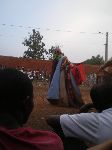
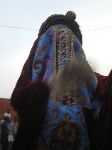
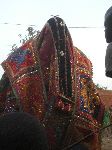
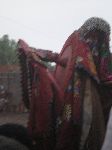
[Above and below are ancestor figures from the family celebration -- see
sidebar.]
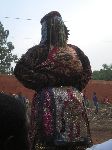
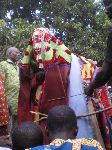
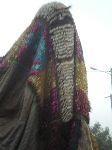

Akaba: 1685-1708, crowned at 50 years old. Royal Symbols: wild boar, chameleon & sword ("Slowly, carefully the chameleon
went to the tree top." The chameleon stands for slowness, which is related
to King Akaba’s long wait for the throne to be vacated. His predecessor was
on the throne for 40 years.)
Agadja: 1708-1741 Initially resisted the slave trade, then became a major slaver.
Lost war with Oyo in 1720. Paid tribute until 1818. Royal Symbols: boat (personne ne pourra mettre le feu a l'abord tombe tout entier
jusqu'aux ranches.) It was under his rule that the kingdom
came into contact with with the Europeans, who arrived on caravel ships.
Tegbessou: 1741-1774. Royal Symbols: buffalo wearing a tunic dressed up ("Once
the buffalo is dress it is very difficult to undress him." This refers
to the story according to which Tegbessou's enemies put an
herbal potion that would cause severe itching on the royal costume,
so when he put it on he would have to remove it immediately. This would have
led to an on-the-spot selection of a new king. Warned in
time, Tegbessou took the necessary precautions.) As Prince Tegbessou
knew that part of an annual tribute required by the Yoruba of Oyo (Nigeria),
remained in the city a long time. Tegbessou King
undertook some successful wars against the Mahi and Nago, but failed against the
Yoruba. Under his reign Whydah became a thriving port and second city of
the Kingdom.
Kpeingla: 1774-1789. Royal Symbols: sparrow and gun, dog defending
territory (the stone in the water doesn't fear the cold.) He strengthened the army and conquered the coastal cities, now located in
Nigeria and Togo. He increased Dahomey involvement in the slave trade.
He worked to expand and consolidate the frontiers of the kingdom.
He sent his army against the Hwedie, the Ouéménou and the Yoruba of Badagri.
Victories and failures marked the path of army which included a corps of Amazons.
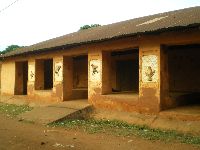 Agonglo: 1789-1797.
Royal Symbols: pineapple (Andean fruit) (the thunder hit the palm tree, but the
pineapple dodged it). The pineapple, which stands for
prudence. He was the first of the Dahomeyan king to marry a European woman.
He attended to the well being of the population through a series of reforms:
He changed the system of import, strengthened the voodoo cult, supported the arts,
and reorganized the structure of the crafts. During his reign the decorations drawn
on walls and pillars of the palaces were changed into low relief, which complemented
the talking drum, the official songs and the appliquéd cloth. He
opened the Kingdom to Christian and Muslims missionaries. He initiated several war
toward its neighbors; the Mahis and the Ouéménous Agonglo: 1789-1797.
Royal Symbols: pineapple (Andean fruit) (the thunder hit the palm tree, but the
pineapple dodged it). The pineapple, which stands for
prudence. He was the first of the Dahomeyan king to marry a European woman.
He attended to the well being of the population through a series of reforms:
He changed the system of import, strengthened the voodoo cult, supported the arts,
and reorganized the structure of the crafts. During his reign the decorations drawn
on walls and pillars of the palaces were changed into low relief, which complemented
the talking drum, the official songs and the appliquéd cloth. He
opened the Kingdom to Christian and Muslims missionaries. He initiated several war
toward its neighbors; the Mahis and the Ouéménous
-- (1798-1817): Despotic king written out of history for being internally violent and not
interested in expansionism.
Ghezo: 1818-1858, 40 years, 40 wars, “killer of elephants”. Royal Symbols: buffalo
without dress (the buffalo can go through a town without hitting
anything). Ghezo ascended to the throne after he
overthrew his brother, Adandozan, in a coup d'état. The traditional
stories state that Adandozan was a cruel ruler, who raised
hyenas to which he would throw
live subjects for amusement. He is never included in the Dahomey appliqués. He is regarded
as a great reformer. He reorganized the structure of the state and
the army, worked on the unification of the Kingdom, and especially developing the
production of palm oil in the context of the abolition slavery. He undertook wars almost
every year and finally liberated the Kingdom from paying tribute to the Oyo (Nigeria).
In 1827, he defeat and enslave Savi (Ouidah). He gave permission to the Catholic to
build a cathedral in village town center. After returning from a war with heavy losses
he was killed.
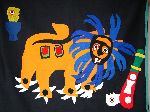 Glele: 1858-1889. Royal Symbols: lion (the teeth of the lion are pushed and feared also). He confronted the interventionism of the Europeans . He consolidated the dominance
over the Dahomey region by conducting more than 30 military campaigns. He failed against Porta Nova, but never the less King Toffa of Porta-Novo requested protection from the French.
King Glele expanded Agbodo" including Dido the source of the city. He developed cultural
practices like music, dances and ritual ceremonies. Glele: 1858-1889. Royal Symbols: lion (the teeth of the lion are pushed and feared also). He confronted the interventionism of the Europeans . He consolidated the dominance
over the Dahomey region by conducting more than 30 military campaigns. He failed against Porta Nova, but never the less King Toffa of Porta-Novo requested protection from the French.
King Glele expanded Agbodo" including Dido the source of the city. He developed cultural
practices like music, dances and ritual ceremonies.
Gbehanzin: 1889-1906, opposed colonial invasion. Exiled by French and died in Algeria.
Royal Symbols: shark and egg in hand (the world takes the egg that the land desires)
He is represented
by a shark and an egg. The proverb: “The world has produced an egg the
weight of which can be felt only by the earth”, refers to the fact that much
was expected of him when he took over the throne. He was successful in
battles against the French, but was finally defeated in 1894.
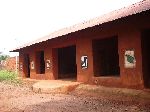 Ago-Li-Agbo: 1894-1900. Enthroned by French and later exiled.
Royal Symbols: leg kicking a rock, bow (a symbol of the return
to traditional weapons under the new rules established by the colonial
administrators), and a broom (Allada stumbles but it does fall.)
Enthroned by the French,
on the advice of his soothsayer, he stood in the palace of his ancestor by the Baobab
with his head down. He commenced to restore the palace of Glele and Guezo.
He appointed his brothers as heads Townships.
Agoli-Agvo could no longer reign as his predecessors. On January 29, 1894 General Dodds
gave a public reading of 16 articles regulating political life in what remains
of the Kingdom. Ago-Li-Ago was in
disgrace because he took his role seriously. He fell February 12, 1900, shortly after
that he was exiled to Gabon. He returned to Dahomey in 1910, lived 15 years in Savé, and
2 years at Mougnon before returning to his private palace, Djegbe, in 1927. Ago-Li-Agbo: 1894-1900. Enthroned by French and later exiled.
Royal Symbols: leg kicking a rock, bow (a symbol of the return
to traditional weapons under the new rules established by the colonial
administrators), and a broom (Allada stumbles but it does fall.)
Enthroned by the French,
on the advice of his soothsayer, he stood in the palace of his ancestor by the Baobab
with his head down. He commenced to restore the palace of Glele and Guezo.
He appointed his brothers as heads Townships.
Agoli-Agvo could no longer reign as his predecessors. On January 29, 1894 General Dodds
gave a public reading of 16 articles regulating political life in what remains
of the Kingdom. Ago-Li-Ago was in
disgrace because he took his role seriously. He fell February 12, 1900, shortly after
that he was exiled to Gabon. He returned to Dahomey in 1910, lived 15 years in Savé, and
2 years at Mougnon before returning to his private palace, Djegbe, in 1927.
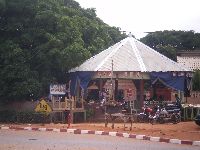
 Circling
around the palaces is the rest of Abomey. Much of what is found is
common to towns in this area. There are hardware stores, dry goods
stores, motor bike repair shops, buvettes (drink stands), markets, Circling
around the palaces is the rest of Abomey. Much of what is found is
common to towns in this area. There are hardware stores, dry goods
stores, motor bike repair shops, buvettes (drink stands), markets,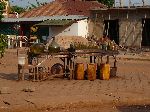
 schools,
a lot of government agencies, offices for non-governmental organizations
from dozens of countries, fuel sellers (out of glass bottles on the
roadside) and health care, both western and traditional. schools,
a lot of government agencies, offices for non-governmental organizations
from dozens of countries, fuel sellers (out of glass bottles on the
roadside) and health care, both western and traditional.
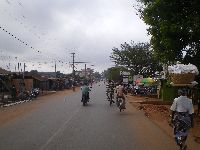
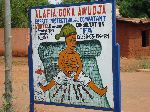

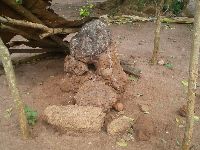 Also around the palaces were various other monuments,
shrines and altars. Also around the palaces were various other monuments,
shrines and altars.
The Temple of
Ahouissou (left) honors Ahouissou,
the originator of Zomadonou worship, established by King Tegbessou (1742-1774). Ahouissou, was a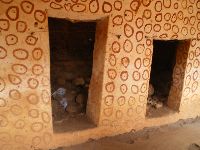 hunter and descendant of King Houegbadja: (1645-1685). As best as I can tell, one day Ahouissou met three people (the son of King Akaba (1685-1708), Kpelou,
the son of the
King Agadja (1708-1741), Adomou, and the son of King Tegbessou (1742-1774)) on the edge of Ouémé
River, who
presented themselves as Zomadonou. The three son had died; two
were badly formed, and now lived in the River. They demand to be reinstalled
in their families as deities. Ahouissou become the first priest of the royal
cult, which is devoted to malformed children and includes a system of 14
royal temples. hunter and descendant of King Houegbadja: (1645-1685). As best as I can tell, one day Ahouissou met three people (the son of King Akaba (1685-1708), Kpelou,
the son of the
King Agadja (1708-1741), Adomou, and the son of King Tegbessou (1742-1774)) on the edge of Ouémé
River, who
presented themselves as Zomadonou. The three son had died; two
were badly formed, and now lived in the River. They demand to be reinstalled
in their families as deities. Ahouissou become the first priest of the royal
cult, which is devoted to malformed children and includes a system of 14
royal temples.
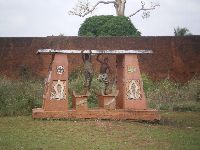 One
is a monument to the Germans-Benin friendship (the boys are not a permanent part of the monument.)
The German element of the monument seems
to be a Maltese Cross. The Beninoise element of the monuments seems to
be represented by symbols of the Abomey Kings. One
is a monument to the Germans-Benin friendship (the boys are not a permanent part of the monument.)
The German element of the monument seems
to be a Maltese Cross. The Beninoise element of the monuments seems to
be represented by symbols of the Abomey Kings.
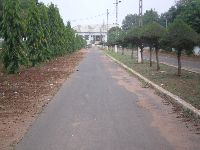 During
the colonial period, from 1895 until to independence in 1960, Abomey had a
substantial official French presences. So that they could properly care for
themselves the French built an official administrative quarter with large
white brick buildings at the end of long drives. Most local people were
forbidden from entering much of this section of town prior to independence. During
the colonial period, from 1895 until to independence in 1960, Abomey had a
substantial official French presences. So that they could properly care for
themselves the French built an official administrative quarter with large
white brick buildings at the end of long drives. Most local people were
forbidden from entering much of this section of town prior to independence.
|
Addendum:
Ancestors Ceremony
Abomey is a town the is steeped in tradition.
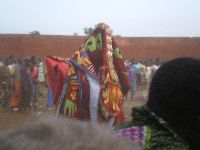
One of those traditions is annual festivals and
ceremonies to honor their ancestors.

At least through the first decade of the 21st
century these were being realized for the benefit of the families and clans,
not modified for the appeal to or perform for tourists.
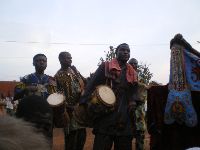 In fact it is not even clear that outsiders are welcome. Foreigners
were not the only ones with dubious status.
In fact it is not even clear that outsiders are welcome. Foreigners
were not the only ones with dubious status.
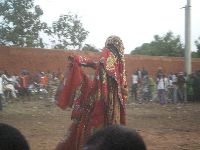 The perimeter of the courtyard was also population with younger people who were trying to get
a glimpse of the actions but were also ready to run if the dancing figure
whirled their way or one of the enforcers waved a switch in their directions.
The perimeter of the courtyard was also population with younger people who were trying to get
a glimpse of the actions but were also ready to run if the dancing figure
whirled their way or one of the enforcers waved a switch in their directions.
After arriving at the edge of one ceremony we
were spotted by one man who thought that the group of visitors should be in the V.I.P. section.

As soon as he started to lead some of us there
other men intervene to oppose it. For a moment some of us were
literally in the middle of a tug-a-war. The physical jostling ended
quickly but the confusion continued as the men debated about the groups
status and an appropriate location. As this went on more men were
drawn into the discussion. It is not clear how they arrived at a decision,
but after a
modest delay we were whisked to the front.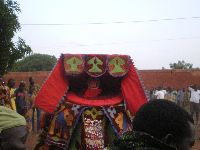
Even with a nearly front row seat it was hard
to photograph the event: There was action in too many directions, the
movement was fast, sometimes the dancers were too close and the light was
waning.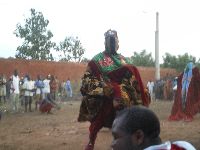
The central figures in the performance are the
spirits of the ancestors (masked and general dressed in elaborate clothes),
the musicians and their associates, who assisted the spirit and kept order
among the spectators.
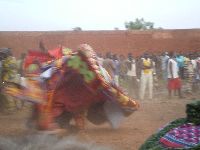 When the masks danced layers upon layers of material would fly up. It
is hard to imaging how much the clothing weights, how hot it is to wear and
how hard it is to dance.
When the masks danced layers upon layers of material would fly up. It
is hard to imaging how much the clothing weights, how hot it is to wear and
how hard it is to dance.
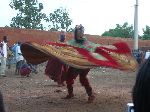
After a long interval of watching the performance, about as abruptly as we were ushered in, we were
whisked out -- almost
at a run. It was never explained why, but evident whatever was next in
the progression of the event, it was sacred and outsiders and the
uninitiated weren't suppose to see it. A lot of the young people were
scurrying away at the same time.
Amazon Ceremony
A second ceremony in another part of town was dominated by women
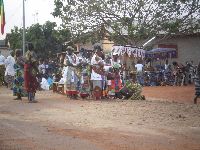 associated with the 'Amazon' court -- but still the crowd control was handled by men. And
associated with the 'Amazon' court -- but still the crowd control was handled by men. And
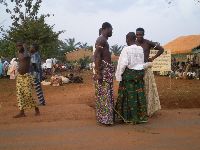 visitors were again given preferential seating. The culminating event
of the ceremony was the
visitors were again given preferential seating. The culminating event
of the ceremony was the
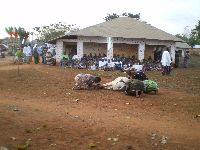 sacrificing of a white cow. As the time approached the women formed
such a dense wall
sacrificing of a white cow. As the time approached the women formed
such a dense wall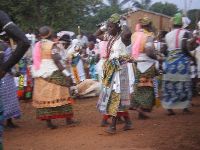 around the animal that the audience was not privy to the ritual.
around the animal that the audience was not privy to the ritual.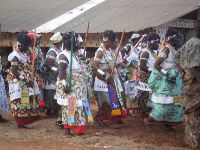
The Amazon corps was established by Queen Hangbe (1708-1711). They provide security and assault in the final wars.
King Guezo (1818-1858) reorganized this army. The court at the time of Guezo was greater
than today, with 200 Amazons. They represented 30% of the army. They were recruited between
12 and 14 years old, in villages and urban centers and among the captives of war and selected
according to their physical stoutness. The training took place at Zassi in the former palace
of the King. |
 An
interesting part of the African economy is how different villages will have
their own specialization. In the case of this village, perhaps
Paouignan, it is a cassava
or manioc product with dozens of vendors lining both sides of the road. Though
it is unlikely that anyone in town has academically studied it, this is a
dramatic demonstration of
An
interesting part of the African economy is how different villages will have
their own specialization. In the case of this village, perhaps
Paouignan, it is a cassava
or manioc product with dozens of vendors lining both sides of the road. Though
it is unlikely that anyone in town has academically studied it, this is a
dramatic demonstration of comparative advantage, the cluster effect, the economy of agglomeration (or perhaps the diseconomy of agglomeration) and maybe the
economies of scale. When automobile dealers or shoe shops cluster it
is fairly easy to determine at least some of the differences in the product
(i.e. style, color, size) and there may be some information available about
reputation. In this market ALL of the product seems IDENTICAL so does
that mean the only factor in a purchasing decision is reputation, or is it
total random -- not something economist pretend to understand.
comparative advantage, the cluster effect, the economy of agglomeration (or perhaps the diseconomy of agglomeration) and maybe the
economies of scale. When automobile dealers or shoe shops cluster it
is fairly easy to determine at least some of the differences in the product
(i.e. style, color, size) and there may be some information available about
reputation. In this market ALL of the product seems IDENTICAL so does
that mean the only factor in a purchasing decision is reputation, or is it
total random -- not something economist pretend to understand.



















































